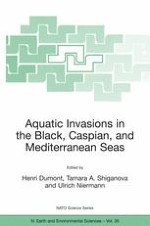The present volume contains the presentations of a NATO advanced Research Workshop (ARW) entitled “The invasion of the Black, Mediterranean and Caspian Seas by the American Ctenophore, Mnemiopsis leidyi Agassiz: a multidisciplinary perspective and a comparison with other aquatic invasions”, held on 24 - 26 June 2002 in Baku (Azerbaijan). The meeting was ?nanced by the NATO Division for Scienti?c and Environmental Affairs (Brussels); substantial logistic support was provided by the CEP (Caspian Environmental Program) of the GEF in Baku. The Mediterranean, Black, and Caspian Seas represent three fragments of the former Tethys Sea, and are thus of great interest to understanding the evolution of the entire region where Eurasia, Africa and the Arabian Peninsula meet. While the Mediterranean is a typical marine environment, with salinity even a little above the world ocean’s, the Black Sea is a brackish meromictic lake, and the Caspian is a lake with a saline gradient extending from a freshwater basin in the North to a brackish water basin in the South. Intense ?shing activity takes place in all three seas, while maritime traf?c through the Dardanelles and Bosporus, and via the Lenin Canal (between the Don and Volga rivers) to the Caspian Sea has become greatly intensi?ed in the course of the last few decades.
